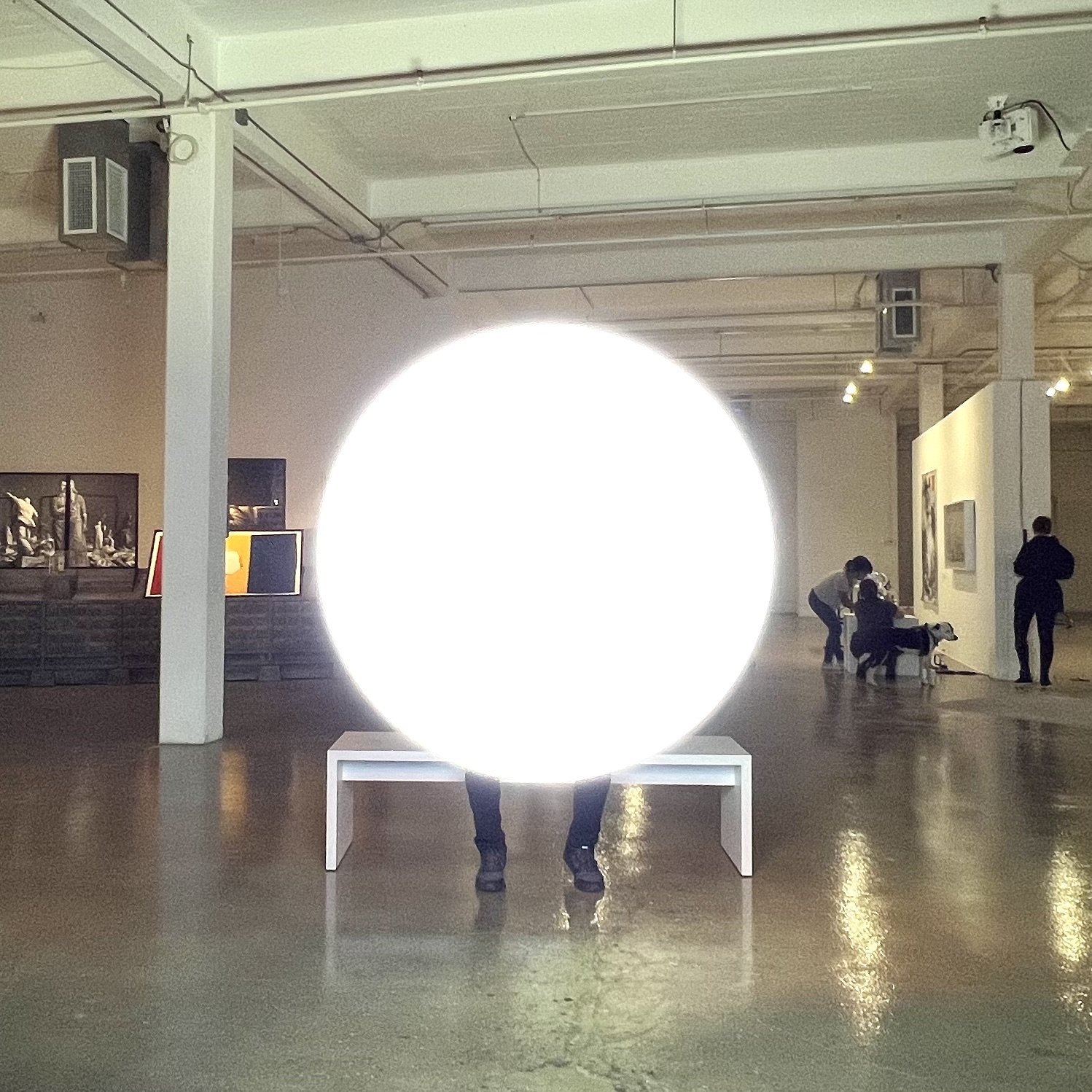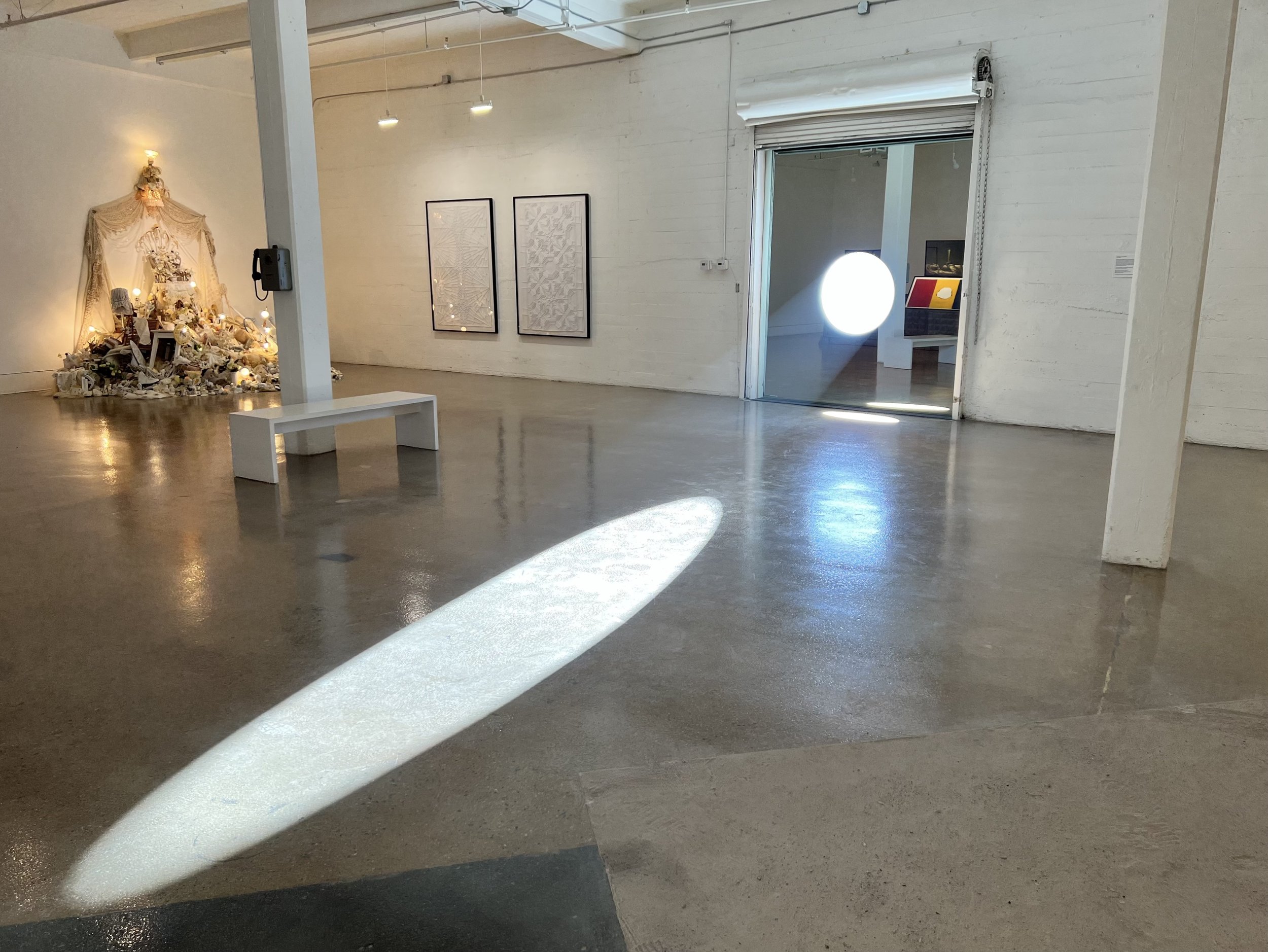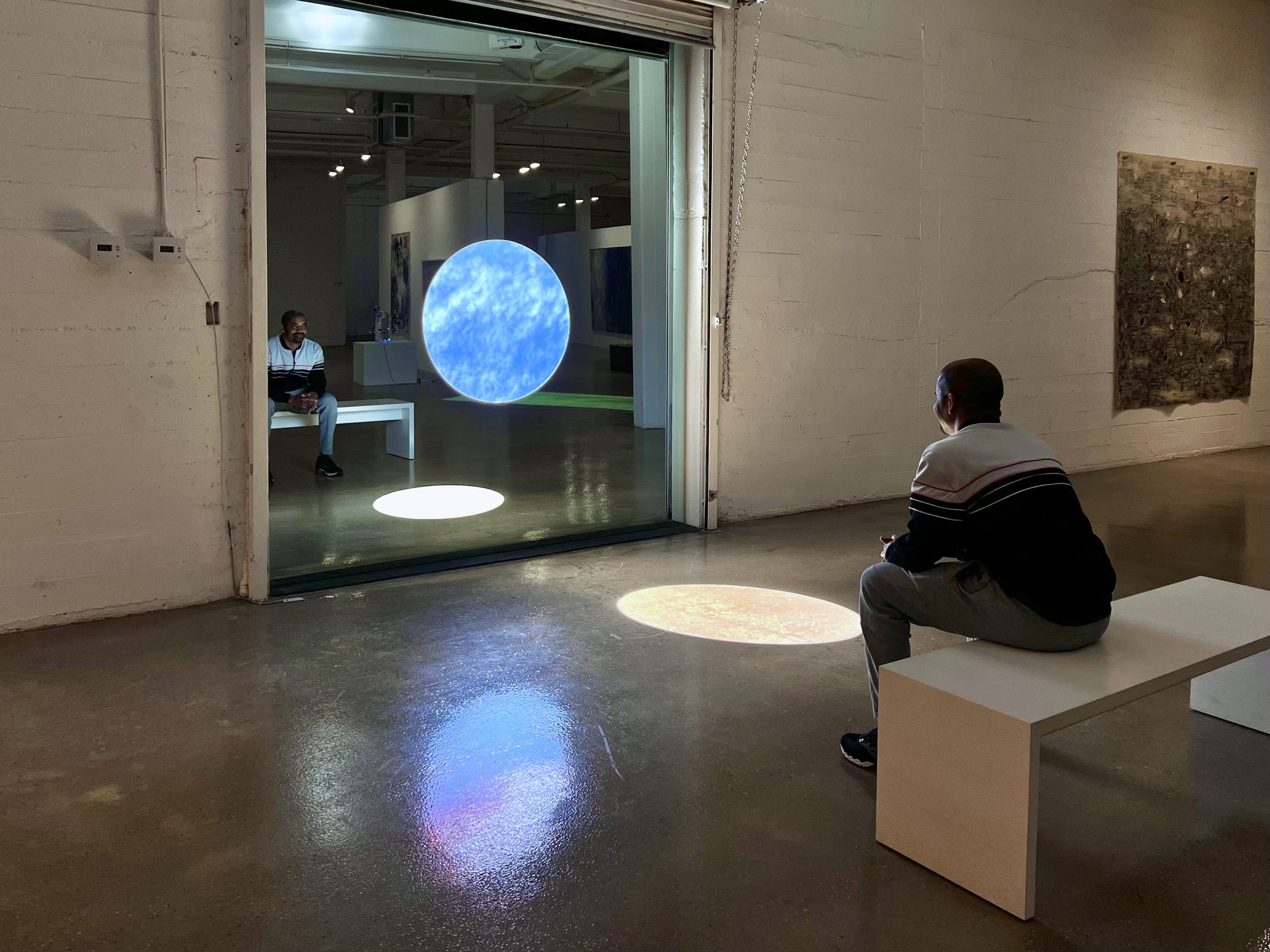Atma Curatorial Notes
Atma Curatorial Notes
Atma was part of a group exhibition entitled “Here After” which highlighted various traditional perspectives on the concept of the afterlife. Atma was dedicated to the artist’s dear friend who had recently died.
On the word Atma:
Atma is Sanskrit word which refers to essence, breath, soul, or self. The Indian word Ātman is taken from Atma, and in Indian philosophy means True Self of an individual, their innermost essence, pure self, pure consciousness. It is said that ones True Self (Atman) is identical with Brahman (God, the Absolute, the eternal Truth which is the Supreme Self.)
Philosophical schools such as Advaita (non-dualism) see the Atma or Atman as the "spirit" within each living entity as being fully identical with Brahman – the Source or the Principle, the ground of all being.
Yajnavalkya (c. 9th cenutry BCE), in the Brihadaranyaka Upanishad, uses the term Atman to indicate that in which everything exists and which permeates everything. This is similar to the Christian concept of living in Christ, “in Him we live and move and have our being” from Acts 17:28 in Christian New Testament and the Christian concept of the Christ Self, which is one with the Old Testament I AM.
In Hindu philosophy, especially in the Vedanta school of Hinduism, Ātman is the first principle, the True Self of an individual beyond identification with phenomena, the essence of an individual. In order to attain freedom (liberation), a human being must acquire self-knowledge (atma jnana), which is not ego knowledge, but rather knowledgeable of one's True Self (Atma or Ātman), the transcendent Self, Brahman (or Paramatman):
"If Atman is Brahman in a pot (the body), then one need merely break the pot to fully realize the primordial unity of the individual soul with the plentitude of Being that was the Absolute.[1]
The Rumi poem below underlines this sense of finding union with God which is also the central theme of Eastern Orthodox Christianty also known as theosis. The overall concept is that through union with God one finds union with ALL, including our loved ones, for eternity...
Out beyond ideas of wrongdoing and rightdoing
there is a field. I'll meet you there.
When the soul lies down in that grass,
the world is too full to talk about.
Ideas, language, even the phrase "each other" doesn't make any sense.
Translation of Talal al-Din Rumi by Coleman Bark
On the initial symbolism of the work, including the significance of the work being build into the gallery’s threshold / doorway.
In Atma, we see our body transfigured and encircled or merged with the singular purity of the light and atmosphere that sustains us (and all living things), which we live in and breath in daily as our very breath.
This calls back to the ancient story of the Transfiguration of Christ (seen below). We see ourselves and this light merge together, held within this threshold space, this open doorway, which is an archetypal symbol of the known and unknown, the inner and the outer world, between sleeping and waking, death and life, and opening from the everyday to the transcendent, a place of transition from one state to another.
Orthodox Icon of the Transfiguration of Christ. by Philip Davydov. 50 X 40 cm (20 X 16 inches), 2017
Note the blue circle of light consuming Christ and beaming out towards the disciples.
The work then becomes an alchemical apparatus bringing down the immateriality of the light and presence of the sky and allowing it to become physicalized, merging it with our bodies. So that which seems beyond comes near, where we not only sit face to face with it, but we become engulfed by it, revealing our own transfiguration— reminding us of the glory of our truest Self, our deepest incorruptible essence, which is, like the sky, the the breath of life, light from light.
“For now we see in a glass darkly, but then face to face”
1 Corinthians 13:12, from the Christian New Testament
Here, the sky comes down to look into us as much or more than we are there looking into it, reminding us of the Presence that is here with us, and in us, with each breath.
Like Rumi spoke of above, this place where we meet, is not just a place found in the here after, but it can be found here, even now. We meet there not by gazing at each other, but in looking outward and inward together in the same direction, meeting in that field of belonging and beholding. It is a place of rest and re-membering, reconnecting to the deep bodied knowing that we have come from Love, we live in Love, and to Love we shall return.
So this work becomes a contemplative quiet listening space to perhaps find a deeper sense of connection to this idea in a more physical way. This is something that was witnessed happening in the gallery by numerous visitors and was not prompted by any text.
In regards to the above mentioned alchemical apparatus, most of alchemy has to do with this idea of incarnation, spirit and matter becoming one, which you can see here in this alchemical text by Solomon Trismosin, The Splendor Solis, (The Splendor of the Sun) Plate 1, Arma Artis, (or The Arms of Art) (1582 in the British Museum, pictured below). The sun, the light or spirit descends downwards, fire moving through the mysterious dark moon-starry waters into the physicality of the shield (which happens to be tilted at 45º in the picture, and reflecting the sky), the sky / sun / light / spirit are descending down and coming into physical form on earth. And, coincidentally, 45 is the Hebrew word for Adam, אדם, meaning “humanity” or “earth”.
-------------------------------
On the significance of Glass, Mirror, Frame, Sun:
Glass
Humans have been using glass for over 4000 years in Mesopotamia and Egypt. Medieval alchemists made glass their distinctive symbol for their official work of transmutation because it referenced a transparent vessel where the process of transformation at many levels takes place (which happens with sand becoming a liquid and then amorphous solid and back to a liquid)
Glass was also associated with salt and ash, symbolically the distilled residues of physical and psychical processes of calcination, sublimation, and purification. [2]
Glass is also a symbol of clarity, insight, and vision and is used as such in Atma. Not to mention glass is the way we connect to the world at large and is perhaps the defining material of our age (eye glasses, microscopes, telescopes, phones, watches, computers, windows, buildings, even the internet runs through glass fibers around the globe to allow us to learn and communicate and exchange goods etc.)
Mirror
Mirror has always existed, before glass and metal there were puddles, ponds, and lakes, and in such reflections it was believed that the essential essence or soul of a person could be perceived.
In accent Egypt, mirrors where associated with the essential nature of a thing. The Egyptian hieroglyph for life: the ankh, which was the word for life was also the word for mirror. [2]
A mirror also represented the solar disk as the source of light that contained life’s essence. This was seen clearly in ancient Shinto shrines:
"The circular mirror of Shinto is a potent symbol. One often sees it when visiting shrines, where it stands on the altar as representative of the kami (a divine being) and sometimes functions as the ‘spirit-body’ (goshintai) of the kami. The idea is that the spirit enters into the object to take physical form." [3]
(Much like the sky and sun do in the gallery through the mirror.)
"The mirror thus acts as an interface between the physical and spiritual realms of existence." [3]
"Japanese mythology claims that the original ‘spirit-body’ was that of Amaterasu, the Sun Goddess,” [3] (Ama means “heaven" and terasu is “shining": so she is literally, the Heaven Shining one -which is what we become as we sit in front of Atma).
The story goes that Amaterasu gave a circular mirror to her grandson, Ninigi, when he descended to earth, believing it held her essence and could be gazed upon to truly see the Heaven Shining one anytime.
The ancient Chinese believed the human soul to also be a shining disc, a connotation that carried over to the circular mirror.
Frame
In Atma, we encounter a void, a negative space, a 33 inch diameter opening which holds a particular Presence within it. But this Presence expands far and farther beyond its own framed borders. The narrow frame is only the beginning of the revelation that is held within it. Much like us. There is an endlessness to it, to where we can go, and the further we look out, the further we look in.
It is also interesting to note that the Presence of YHWH, in the Old Testament, was said to also reside in the negative space between the angel tips on the ark in the Holy of Holies in ancient Israel’s tabernacle and temple.
Sun
Atma harnesses the sun and allows it to be revealed in unique ways within the gallery space. It focuses the sun’s light allowing it to move through the gallery, illuminating it, unfolding in time. There is a special kind of bright light, Glory, or Presence that is associated with the beaming onto the face of the faithful, and here one gets to experience that in a very direct way.
There is a lot of talk about “seeing the light” or “experiencing light” or “encountering a bright light” in regards to near death experiences. Here, from late morning through to the afternoon, anyone that walks up to the work will experience such a glow, beaming onto their face. A blast of the pure life-sustaining power of the sun.
The entire work then inhabits the gallery itself, and the visitor experiences it in a very physical and embodied way.
Refrences:
1. David Gordon White, (1996). The Alchemical Body: Siddha Traditions in Medieval India. Chicago: University of Chicago Press; 18. Quoted online in InfoRefuge "Patanjali’s Yoga Darsana – The Hatha Yoga Tradition." NOTE: Similar identification also made in the Hathayogapradipika (4.50)
2. The Book of Symbols, Reflections on Archetypal Images, p. 588-592
3. https://www.greenshinto.com/2012/02/18/the-circular-mirror-shinto-symbol/












